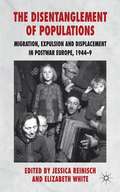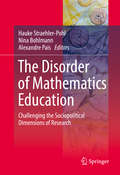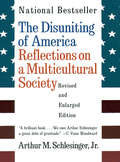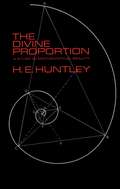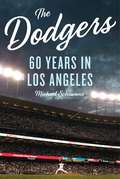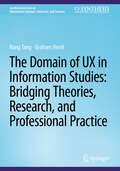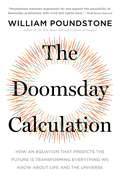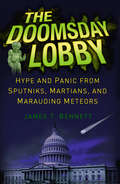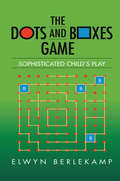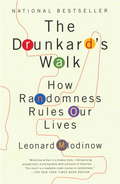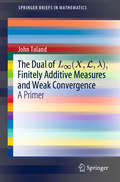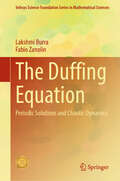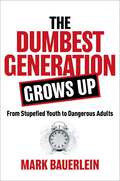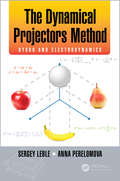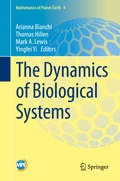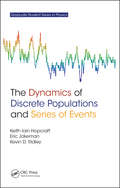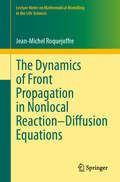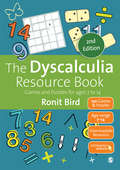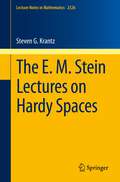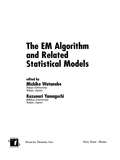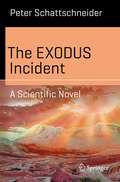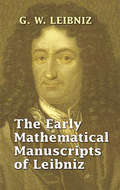- Table View
- List View
The Disentanglement of Populations
by Elizabeth White Jessica ReinischAn examination of population movements, both forced and voluntary, within the broader context of Europe in the aftermath of the Second World War, in both Western and Eastern Europe. The authors bring to life problems of war and post-war chaos, and assess lasting social, political and demographic consequences.
The Disorder of Mathematics Education
by Hauke Straehler-Pohl Nina Bohlmann Alexandre PaisResearch within a socio-political paradigm or "turn" has been gradually recognized and institutionalized as an important part of mathematics education. This book focuses on the neglected problems, tensions and contradictions evoked by this process. The authors do this by challenging current regimes of truth about mathematics education; by identifying how recent technological developments challenge or suspend contemporary conceptions of mathematics education; by critiquing the ideological entanglement of mathematics, its education and schooling with capitalism; by self-reflective analyses of researchers' impacts on shaping what is and can be perceived as the practice of mathematics education (research); and by confronting main-stream mathematics education with socio-political contexts that are usually neglected. In this way, "mathematical rationality" becomes contextualized within contemporary society, where it reproduces itself through technologies, social practices, media and other spheres of social life.
The Disuniting of America: Reflections on a Multicultural Society (Revised and Enlarged Edition)
by Arthur Meier SchlesingerThe bestseller that reminded us what it means to be an American is more timely than ever in this updated and enlarged edition, including "Schlesinger's Syllabus," an annotated reading list of core books on the American experience. The classic image of the American nation -- a melting pot in which differences of race, wealth, religion, and nationality are submerged in democracy -- is being replaced by an orthodoxy that celebrates difference and abandons assimilation. While this upsurge in ethnic awareness has had many healthy consequences in a nation shamed by a history of prejudice, the cult of ethnicity, if pressed too far, threatens to fragment American society to a dangerous degree. Two-time Pulitzer Prize winner in history and adviser to the Kennedy and other administrations, Arthur M. Schlesinger, Jr., is uniquely positioned to wave the caution flag in the race to a politics of identity. Using a broader canvas in this updated and expanded edition, he examines the international dimension and the lessons of one polyglot country after another tearing itself apart or on the brink of doing so: among them the former Yugoslavia, Nigeria, even Canada. Closer to home, he finds troubling new evidence that multiculturalism gone awry here in the United States threatens to do the same. "One of the most devastating and articulate attacks on multiculturalism yet to appear."--Wall Street Journal "A brilliant book . . . we owe Arthur Schlesinger a great debt of gratitude."--C. Vann Woodward, New Republic
The Divine Proportion
by H. E. HuntleyUsing simple mathematical formulas, most as basic as Pythagoras's theorem and requiring only a very limited knowledge of mathematics, Professor Huntley explores the fascinating relationship between geometry and aesthetics. Poetry, patterns like Pascal's triangle, philosophy, psychology, music, and dozens of simple mathematical figures are enlisted to show that the "divine proportion" or "golden ratio" is a feature of geometry and analysis which awakes answering echoes in the human psyche. When we judge a work of art aesthetically satisfying, according to his formulation, we are making it conform to a pattern whose outline is laid down in simple geometrical figures; and it is the analysis of these figures which forms the core of Professor Huntley's book.For the philosopher, scientist, poet, art historian, music listener, artist, as well as the general reader who wants to understand more about the fascinating properties of numbers, this is a beautifully written, exciting account of the search for a naturally manifested aesthetic that has occupied man since he first asked the question "why?""This is a delightful book to read. . . . It wanders here and there through some of the most attractive byways of simple mathematics, returning always to the oddities and pleasures of the golden section. This is a browser's book — a happy, untidy traveling or bedside book for those who know how to enjoy the charm of numbers and shapes." — Dr. J. Bronowski, The Salk Institute.
The Dodgers: 60 Years in Los Angeles
by Schiavone MichaelIn 1957, the Dodgers left their home of Brooklyn, New York, where they had been since their inception in 1884, for the sunny hills of Los Angeles, California. Since arriving in LA, the team has won five World Series and ten NL Pennants, and become one of the top-grossing organizations in Major League Baseball.The Dodgers: 60 Years in LA chronicles the team’s impressive history since arriving in the West Coast. Covering the amazing feats of Dodgers greats such as Steve Garvey, Fernando Valenzuela, and Kirk Gibson, author Michael Schiavone offers an in-depth history of the team since their arrival in 1958 and through the 2017 season.With highlights of each season, the moments fans love to remember (or wish to forget), as well as those who have graced the field of Chavez Ravine, The Dodgers: 60 Years in LA shares the wonderful history of the boys in blue in the most comprehensive book available. Whether you’re a fan of the Dodgers of old or today’s team, this book offers the most information of the team’s time in California than any other on the market.
The Domain of UX in Information Studies: Bridging Theories, Research, and Professional Practice (Synthesis Lectures on Information Concepts, Retrieval, and Services)
by Rong Tang Graham HerrliThis book bridges the gap between academic and applied User Experience (UX) research, offering a fresh perspective on uniting these two communities. Drawing from their extensive professional experience in both realms, the authors delve into the varying definitions, models, and methods that distinguish academic and applied UX practices. Through a thoughtful analysis of communication styles and research dissemination, the book highlights how the disconnect and differences hinder the progress in the UX field. More importantly, the authors emphasize the urgent need for greater integration between the academic and applied UX communities. To address this, the authors present a comprehensive framework for converging these perspectives, fostering collaboration and innovation. By bridging this divide, the book seeks to strengthen, advance, and empower the UX discipline, making it an essential resource for researchers, practitioners, and anyone invested in the future of UX. In addition, this book: Examines the concept of UX as defined in both academic and applied research settings, highlighting the gaps between the two Explains how inconsistent definitions, methods, and communication strategies hinder UX research progress Proposes actionable steps to bridge the gap between academic and applied UX, benefiting both communities
The Doomsday Calculation: How an Equation that Predicts the Future Is Transforming Everything We Know About Life and the Universe
by William PoundstoneFrom the author of Are You Smart Enough to Work at Google?, a fascinating look at how an equation that foretells the future is transforming everything we know about life, business, and the universe.In the 18th century, the British minister and mathematician Thomas Bayes devised a theorem that allowed him to assign probabilities to events that had never happened before. It languished in obscurity for centuries until computers came along and made it easy to crunch the numbers. Now, as the foundation of big data, Bayes' formula has become a linchpin of the digital economy.But here's where things get really interesting: Bayes' theorem can also be used to lay odds on the existence of extraterrestrial intelligence; on whether we live in a Matrix-like counterfeit of reality; on the "many worlds" interpretation of quantum theory being correct; and on the biggest question of all: how long will humanity survive?The Doomsday Calculation tells how Silicon Valley's profitable formula became a controversial pivot of contemporary thought. Drawing on interviews with thought leaders around the globe, it's the story of a group of intellectual mavericks who are challenging what we thought we knew about our place in the universe. The Doomsday Calculation is compelling reading for anyone interested in our culture and its future.
The Doomsday Lobby
by James T. BennettFederal patronage of science was never contemplated by the framers of the Constitution, but they did seek to "promote the Progress of Science and useful Art" by granting inventors patent rights. However, direct subvention to scientists and scientific organizations was not considered appropriate activity of the central government. In the 19th Century, American science was funded almost entirely through private investors. Since WWII, however, the federal government has become the primary patron of American science. From the race-to-space in the 1950s to current furor over global warming, Bennett traces the subtle and not-so-subtle ways in which government has co-opted scientific research and reinforced a culture in which challengers to proscribed wisdom are frozen out. Citing original documents and media reports, Bennett offers a compelling, entertaining, and thought-provoking perspective on political influence on scientific research and its implications for a democratic society. "During the Nineteenth Century, almost entirely on private funding, American science grew from practically nothing to world class. Now, however, over fifty percent of American science is funded by the federal government. Dr. Bennett traces the path, "crisis" after "crisis," by which American science became practically an arm of the federal government. His tale is a cautionary one, warning against future "crisis mongers" who would extend the government's already majority control of American science even further. His warning is a timely one, and it should be heeded." Joseph P. Martino, author of Science Funding: Politics and Porkbarrel "Bennett's latest book offers a challenging interpretation of the rise of the American federal science establishment since World War II. Focusing primarily on the growth of the space program, Bennett argues that crisis, real or imagined, is the source of state power and state funding for science. The Doomsday Lobby offers what no doubt will be viewed as a controversial contribution to the history of American science policy, and more broadly to an understanding of the role of the state in society." James D. Savage, Professor of Politics, University of Virginia, and author of Funding Science in America
The Dots and Boxes Game: Sophisticated Child's Play (AK Peters/CRC Recreational Mathematics Series)
by Elwyn R. BerlekampThe game of Dots-and-Boxes, the popular game in which two players take turns connecting an array of dots to form squares, or boxes has long been considered merely a child's game. In this book, however, the author reveals the surprising complexity of the game, along with advanced strategies that will allow the reader to win at any level of gamepla
The Drunkard's Walk: How Randomness Rules Our Lives
by Leonard MlodinowWith the born storyteller's command of narrative and imaginative approach, Leonard Mlodinow vividly demonstrates how our lives are profoundly informed by chance and randomness and how everything from wine ratings and corporate success to school grades and political polls are less reliable than we believe.By showing us the true nature of chance and revealing the psychological illusions that cause us to misjudge the world around us, Mlodinow gives us the tools we need to make more informed decisions. From the classroom to the courtroom and from financial markets to supermarkets, Mlodinow's intriguing and illuminating look at how randomness, chance, and probability affect our daily lives will intrigue, awe, and inspire. From the Trade Paperback edition.d in another it was called the worst wine of the decade? Mlodinow vividly demonstrates how wine ratings, school grades, political polls, and many other things in daily life are less reliable than we believe. By showing us the true nature of change and revealing the psychological illusions that cause us to misjudge the world around us, Mlodinow gives fresh insight into what is really meaningful and how we can make decisions based on a deeper truth. From the classroom to the courtroom, from financial markets to supermarkets, from the doctor's office to the Oval Office, Mlodinow's insights will intrigue, awe, and inspire.Offering readers not only a tour of randomness, chance, and probability but also a new way of looking at the world, this original, unexpected journey reminds us that much in our lives is about as predictable as the steps of a stumbling man fresh from a night at the bar.From the Hardcover edition.
The Dual of L∞: A Primer (SpringerBriefs in Mathematics)
by John TolandIn measure theory, a familiar representation theorem due to F. Riesz identifies the dual space Lp(X,L,λ)* with Lq(X,L,λ), where 1/p+1/q=1, as long as 1 ≤ pL∞(X,L,λ)* cannot be similarly described, and is instead represented as a class of finitely additive measures.This book provides a reasonably elementary account of the representation theory of L∞(X,L,λ)*, examining pathologies and paradoxes, and uncovering some surprising consequences. For instance, a necessary and sufficient condition for a bounded sequence in L∞(X,L,λ) to be weakly convergent, applicable in the one-point compactification of X, is given.With a clear summary of prerequisites, and illustrated by examples including L∞(Rn) and the sequence space l∞, this book makes possibly unfamiliar material, some of which may be new, accessible to students and researchers in the mathematical sciences.
The Duffing Equation: Periodic Solutions and Chaotic Dynamics (Infosys Science Foundation Series)
by Lakshmi Burra Fabio ZanolinThis book discusses the generalized Duffing equation and its periodic perturbations, with special emphasis on the existence and multiplicity of periodic solutions, subharmonic solutions and different approaches to prove rigorously the presence of chaotic dynamics. Topics in the book are presented at an expository level without entering too much into technical detail. It targets to researchers in the field of chaotic dynamics as well as graduate students with a basic knowledge of topology, analysis, ordinary differential equations and dynamical systems. The book starts with a study of the autonomous equation which represents a simple model of dynamics of a mechanical system with one degree of freedom. This special case has been discussed in the book by using an associated energy function. In the case of a centre, a precise formula is given for the period of the orbit by studying the associated period map. The book also deals with the problem of existence of periodic solutions for the periodically perturbed equation. An important operator, the Poincaré map, is introduced and studied with respect to the existence and multiplicity of its fixed points and periodic points. As a map of the plane into itself, complicated structure and patterns can arise giving numeric evidence of the presence of the so-called chaotic dynamics. Therefore, some novel topological tools are introduced to detect and rigorously prove the existence of periodic solutions as well as analytically prove the existence of chaotic dynamics according to some classical definitions introduced in the last decades. Finally, the rest of the book is devoted to some recent applications in different mathematical models. It carefully describes the technique of “stretching along the paths”, which is a very efficient tool to prove rigorously the presence of chaotic dynamics.
The Dumbest Generation Grows Up: From Stupefied Youth to Dangerous Adults
by Mark BauerleinFrom Stupefied Youth to Dangerous Adults Back in 2008, Mark Bauerlein was a voice crying in the wilderness. As experts greeted the new generation of &“Digital Natives&” with extravagant hopes for their high-tech future, he pegged them as the &“Dumbest Generation.&” Today, their future doesn&’t look so bright, and their present is pretty grim. The twenty-somethings who spent their childhoods staring into a screen are lonely and purposeless, unfulfilled at work and at home. Many of them are even suicidal. The Dumbest Generation Grows Up is an urgently needed update on the Millennials, explaining their not-so-quiet desperation and, more important, the threat that their ignorance poses to the rest of us. Lacking skills, knowledge, religion, and a cultural frame of reference, Millennials are anxiously looking for something to fill the void. Their mentors have failed them. Unfortunately, they have turned to politics to plug the hole in their souls. Knowing nothing about history, they are convinced that it is merely a catalogue of oppression, inequality, and hatred. Why, they wonder, has the human race not ended all this injustice before now? And from the depths of their ignorance rises the answer: Because they are the first ones to care! All that is needed is to tear down our inherited civilization and replace it with their utopian aspirations. For a generation unacquainted with the constraints of human nature, anything seems possible. Having diagnosed the malady before most people realized the patient was sick, Mark Bauerlein surveys the psychological and social wreckage and warns that we cannot afford to do this to another generation.
The Dynamical Projectors Method: Hydro and Electrodynamics
by Sergey Leble Anna PerelomovaThe dynamical projectors method proves to reduce a multicomponent problem to the simplest one-component problem with its solution determined by specific initial or boundary conditions. Its universality and application in many different physical problems make it particularly useful in hydrodynamics, electrodynamics, plasma physics, and boundary layer problems. A great variety of underlying mechanisms are included making this book useful for those working in wave theory, hydrodynamics, electromagnetism, and applications. "The authors developed a universal and elegant tool – dynamical projector method. Using this method for very complicated hydro-thermodynamic and electrodynamics problem settings, they were able to get a lot of interesting analytical results in areas where before often just numerical methods were applicable." —L. A. Bordag, University of Applied Sciences Zittau/Görlitz, Zittau, Germany "The book is intended for professionals working in various fields of linear and nonlinear mathematical physics, partial differential equations and theoretical physics. The book is written clearly, and in my opinion, its material will be useful and easy to understand for professionals and for students familiar with ordinary and partial differential equations." —Sergey Dobrokhotov, Russian Academy of Sciences, Moscow, Russia
The Dynamics of Biological Systems (Mathematics of Planet Earth #4)
by Mark A. Lewis Thomas Hillen Yingfei Yi Arianna BianchiThe book presents nine mini-courses from a summer school, Dynamics of Biological Systems, held at the University of Alberta in 2016, as part of the prestigious seminar series: Séminaire de Mathématiques Supérieures (SMS). It includes new and significant contributions in the field of Dynamical Systems and their applications in Biology, Ecology, and Medicine. The chapters of this book cover a wide range of mathematical methods and biological applications. They - explain the process of mathematical modelling of biological systems with many examples, - introduce advanced methods from dynamical systems theory, - present many examples of the use of mathematical modelling to gain biological insight- discuss innovative methods for the analysis of biological processes,- contain extensive lists of references, which allow interested readers to continue the research on their own. Integrating the theory of dynamical systems with biological modelling, the book will appeal to researchers and graduate students in Applied Mathematics and Life Sciences.
The Dynamics of Discrete Populations and Series of Events
by Keith Iain Hopcraft Eric Jakeman Kevin D. RidleyDiscrete phenomena are an important aspect of various complex systems, acting both as underlying driving mechanisms and as manifestations of diverse behaviours. However, the characterisation of these discrete phenomena requires models that go beyond those featured in existing books. Largely concerned with mathematical models used to describe time-v
The Dynamics of Front Propagation in Nonlocal Reaction–Diffusion Equations (Lecture Notes on Mathematical Modelling in the Life Sciences)
by Jean-Michel RoquejoffreThe book provides a self-contained and complete description of the long time evolution of the solutions to a class of one-dimensional reaction–diffusion equations, in which the diffusion is given by an integral operator. The underlying motivation is the mathematical analysis of models for biological invasions. The model under study, while simple looking, is of current use in real-life situations. Interestingly, it arises in totally different contexts, such as the study of branching random walks in probability theory. While the model has attracted a lot of attention, and while many partial results about the time-asymptotic behaviour of its solutions have been proved over the last decades, some basic questions on the sharp asymptotics have remained unanswered. One ambition of this monograph is to close these gaps. In some of the situations that we envisage, the level sets organise themselves into an invasion front that is asymptotically linear in time, up to a correction that converges exponentially in time to a constant. In other situations that constitute the main and newest part of the work, the correction is asymptotically logarithmic in time. Despite these apparently different behaviours, there is an underlying common way of thinking that is underlined. At the end of each chapter, a long set of problems is proposed, many of them rather elaborate and suitable for master's projects or even the first question in a PhD thesis. Open questions are also discussed. The ideas presented in the book apply to more elaborate systems modelling biological invasions or the spatial propagation of epidemics. The models themselves may be multidimensional, but they all have in common a mechanism imposing the propagation in a given direction; examples are presented in the problems that conclude each chapter. These ideas should also be useful in the treatment of further models that we are not able to envisage for the time being. The book is suitable for graduate or PhD students as well as researchers.
The Dyscalculia Resource Book: Games and Puzzles for ages 7 to 14
by Ronit BirdWritten by a teacher for teachers, the second edition of Ronit Bird’s The Dyscalculia Resource Book now comes with 120 games and puzzles and a brand new section on ‘mixed operations puzzles’ which require learners to switch mentally between addition, subtraction, multiplication and division. The new edition will also provide access to an accompanying website featuring demo videos of different games and puzzles and the option to easily download and print all the games and puzzles in the book! Ideal for working with students 7 to 14 years old, this is the perfect companion to The Dyscalculia Toolkit, essential additions to every teachers’ resource collection.
The Dyscalculia Resource Book: Games and Puzzles for ages 7 to 14
by Ronit BirdWritten by a teacher for teachers, the second edition of Ronit Bird’s The Dyscalculia Resource Book now comes with 120 games and puzzles and a brand new section on ‘mixed operations puzzles’ which require learners to switch mentally between addition, subtraction, multiplication and division. The new edition will also provide access to an accompanying website featuring demo videos of different games and puzzles and the option to easily download and print all the games and puzzles in the book! Ideal for working with students 7 to 14 years old, this is the perfect companion to The Dyscalculia Toolkit, essential additions to every teachers’ resource collection.
The E. M. Stein Lectures on Hardy Spaces (Lecture Notes in Mathematics #2326)
by Steven G. KrantzThe book The E. M. Stein Lectures on Hardy Spaces is based on a graduate course on real variable Hardy spaces which was given by E.M. Stein at Princeton University in the academic year 1973-1974. Stein, along with C. Fefferman and G. Weiss, pioneered this subject area, removing the theory of Hardy spaces from its traditional dependence on complex variables, and to reveal its real-variable underpinnings.This book is based on Steven G. Krantz’s notes from the course given by Stein. The text builds on Fefferman's theorem that BMO is the dual of the Hardy space. Using maximal functions, singular integrals, and related ideas, Stein offers many new characterizations of the Hardy spaces. The result is a rich tapestry of ideas that develops the theory of singular integrals to a new level. The final chapter describes the major developments since 1974.This monograph is of broad interest to graduate students and researchers in mathematical analysis. Prerequisites for the book include a solid understanding of real variable theory and complex variable theory. A basic knowledge of functional analysis would also be useful.
The EM Algorithm and Related Statistical Models (Statistics: A Series Of Textbooks And Monographs #170)
by Michiko Watanabe Kazunori YamaguchiExploring the application and formulation of the EM algorithm, The EM Algorithm and Related Statistical Models offers a valuable method for constructing statistical models when only incomplete information is available, and proposes specific estimation algorithms for solutions to incomplete data problems. The text covers current topics including statistical models with latent variables, as well as neural network models, and Markov Chain Monte Carlo methods. It describes software resources valuable for the processing of the EM algorithm with incomplete data and for general analysis of latent structure models of categorical data, and studies accelerated versions of the EM algorithm.
The EXODUS Incident: A Scientific Novel (Science and Fiction)
by Peter SchattschneiderIn the near future, Earth is suffering from climate change, famines, and fundamentalism. A global nuclear war is imminent. Interstellar probes from the Breakthrough Starshot project initiated by J. Milner and S. Hawking have discovered a habitable planet in the stellar system Proxima Centauri, just in time for the exodus of the elites. On board the EXODUS starship, the crew starts to experience strange things. The voyage to Atlantis, the new home for mankind, enters a mysterious and disquieting territory, where conspiracy theories about what is real and what is virtual emerge. THE EXODUS INCIDENT is a novel about an interstellar journey, which connects science to virtual realities and epistemology. In the guise of a final investigative report, a scientific treatise discusses the physics and mathematics behind the story: the starship, the fusion thruster, the target planet, and the journey, addressing anomalous effects which involve relativistic speed and deep space environments.
The Early Mathematical Manuscripts of Leibniz
by G. W. Leibniz J. M. ChildThe manuscripts and correspondence of Leibniz possess a special interest: they are invaluable as aids to the study of their author's part in the invention and development of the infinitesimal calculus. In addition, the main ideas behind Leibniz's philosophical theories lay here, in his mathematical work.This volume consists of two sections. The first part features Leibniz's own accounts of his work, and the second section comprises critical and historical notes and essays. An informative Introduction leads to the "postscript" to Leibniz's 1703 letter to James Bernoulli, his "Historia et Origio Calculi Differentialis," and manuscripts of the period 1673-77. Essays by the distinguished scholar C. I. Gerhardt follow--Leibniz in London and Leibniz and Pascal, along with additional letters and manuscripts by Leibniz.
The Early Period of the Calculus of Variations
by Paolo Freguglia Mariano GiaquintaThis monograph explores the early development of the calculus of variations in continental Europe during the Eighteenth Century by illustrating the mathematics of its founders. Closely following the original papers and correspondences of Euler, Lagrange, the Bernoullis, and others, the reader is immersed in the challenge of theory building. We see what the founders were doing, the difficulties they faced, the mistakes they made, and their triumphs. The authors guide the reader through these works with instructive commentaries and complements to the original proofs, as well as offering a modern perspective where useful. The authors begin in 1697 with Johann Bernoulli's work on the brachystochrone problem and the events leading up to it, marking the dawn of the calculus of variations. From there, they cover key advances in the theory up to the development of Lagrange's δ-calculus, including: * The isoperimetrical problems * Shortest lines and geodesics * Euler's Methodus Inveniendi and the two Additamenta Finally, the authors give the readers a sense of how vast the calculus of variations has become in centuries hence, providing some idea of what lies outside the scope of the book as well as the current state of affairs in the field. This book will be of interest to anyone studying the calculus of variations who wants a deeper intuition for the techniques and ideas that are used, as well as historians of science and mathematics interested in the development and evolution of modern calculus and analysis.
The Early-Career Professional’s Guide to Generative AI: Opportunities and Challenges for an AI-Enabled Workforce
by Jonas BjergThe world stands at a pivotal moment due to the emergence of Generative AI, specifically ChatGPT. This groundbreaking technology has provoked and impressed almost every industry globally, evoking every emotion from awe to anxiety. Many are apprehensive about the future, fearing job losses due to rapid artificial intelligence (AI advancements). But if history has taught us anything, progress, while challenging, often paves the way for broader opportunities and growth. This book explains in depth the core building blocks that make up the current landscape of transformer and language models and, more broadly speaking, AI as a whole. We have seen how the internet and the mobile revolution changed our world. Is AI following a similar trajectory? Are we on the verge of something even more transformative? This book strives to provide a complete picture of the challenges and opportunities and the implications for our shared futures. In subsequent chapters, the book will discuss language models in depth. These are not just algorithms; they represent a nexus of linguistics, cognitive science, and cutting-edge technology. You’ll trace AI’s unexpected and exhilarating evolution, observing how it has grown from a mere concept to a force reshaping entire industries. Finally, you’ll consider the rise of AI in the context of advancements. While ChatGPT has gained significant attention for certain applications, it’s essential to recognize that its capabilities extend far beyond what’s immediately evident. Artificial Intelligence, represented by models like ChatGPT, is not a static field. It’s dynamic and ever-evolving, and its potential applications are broadening each day. Technology is not, by any means, limited to chatbots or translation use cases. This book captures this vast and ever-expanding horizon of possibilities. What You Will Learn How large language models came to be, and how they work What ethical AI design looks like The role of regulation in artificial intelligence Why you should not be afraid of losing your job Who This Book is For Working professionals and students in any field
